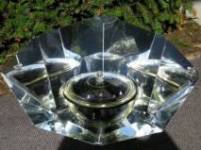
In regions with plenty of sunshine and lack of access to electricity and other types of cooking fuels, solar cookers provide a clean answer to food preparation. In North America solar cooking would be viable in several regions for five to six months a year. The ideal conditions are direct sunlight during four to six hours in a day and little wind. Ambient temperature is irrelevant; more important is to have unobstructed direct sun rays.
“I have successfully cooked I have successfully cooked a pot of quinoa on a brisk March morning in Washington DC, though you’ll do it much quicker in Augustâ€, says Cody Donahue, an American based in Senegal and solar cooker enthusiast.
Solar cooking in Africa
In Africa, where many people don’t have access to electricity, solar cooking is a viable solution to the problem. To celebrate that, on November 27th a group of 1,000 people will get together to cook a meal with solar cookers.
The event will take place in Cape Town’s Khayelitsha neighborhood, where residents suffer with high electricity prices and often have to resort to carbon-intensive materials such as paraffin and wood scraps to cook their meals. The organizers of the event rely on donations coming from all over the globe to make it happen.
Activism
In America, there’s a growing awareness of solar cooking, thanks to the efforts of Solar Household Energy (SHE). Last year, the organization put on a solar cooking demonstration at the GooglePlex in Mt. View, California. Three staff, board members, associates and advocates came together to demonstrate a variety of solar cookers and water pasteurization devices. SHE says Google staff were impressed at the simplicity of what they saw on that sunny day.
According to SHE, there are three types of solar cookers.
First, there’s the Parabolic Cooker, whereby the sun’s rays are captured in a reflector which focuses them at a point under a pot. The effect is like a stove top burner or a campfire. Temperatures can reach above 400 degrees Fahrenheit, hot enough to fry food.
Second, there’s the Box Cooker. With these cookers, sun’s rays are received in an insulated black box with a transparent lid which lets in the sun’s rays. Inside the box, this sunshine turns to heat which is trapped in the box. The effect is similar to the oven in your kitchen. Temperatures can reach around 300 degrees Fahrenheit.
Finally, there’s the Panel Cooker. This is a combination of the two systems which is portable and less expensive. Temperatures can reach around 250 degrees Fahrenheit (which is plenty, they say, as cooking begins at around 180 degrees Fahrenheit.)
Apart from the obvious environmental appeal of solar cookers, these can be of great help in emergency situations, such as refugee camps.
Visit Solar Power Beginner to listen to an interview about solar cooking.






4 Comments